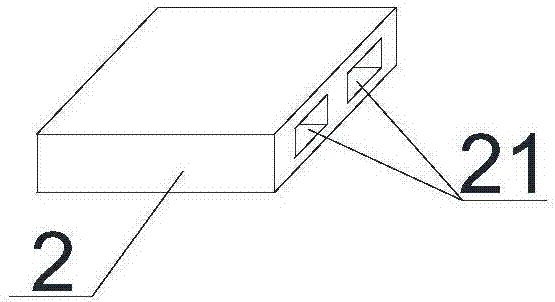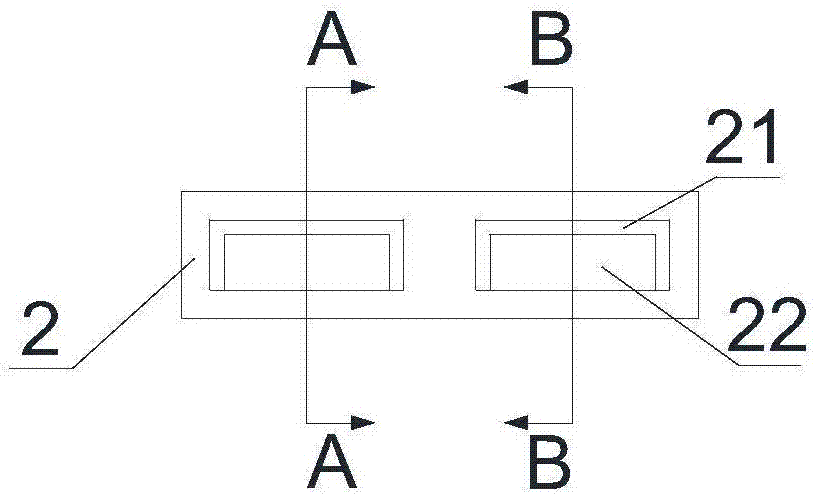Fixing device for joint dislocation or ligament reconstruction
A technology of ligament reconstruction and fixation device, applied in the field of medical devices, can solve the problems of adjusting the length of artificial ligament, inability to choose, etc., and achieve the effect of good fit
- Summary
- Abstract
- Description
- Claims
- Application Information
AI Technical Summary
Problems solved by technology
Method used
Image
Examples
Embodiment 1
[0049] Such as Figure 1-5 A fixing device for joint dislocation or ligament reconstruction is shown, which includes a cable tie body 1 and a main locking head 2. The cable tie body 1 is in the shape of a long strip, and its length direction includes sequentially connected head sections 11 , the first rack section 12, the coracoid process fitting section 14, the second rack section 16 and the tail section 17, wherein the first rack section 12 and the second rack section 16 form a rack 100 respectively, so The coracoid-fitting segment 14 is wide and flat, and the width of the coracoid-fitting segment 14 is greater than the width of the rest of the coracoclavicular ligament 1;
[0050] The main locking head 2 is flat, and the main locking head 2 is provided with two independent rack passing holes 21 in parallel, and each rack passing hole 21 is provided with a rack one-way buckle 22 , the two rack one-way buckles 22 are reversely set;
[0051] The head section 11 and the tail ...
Embodiment 2
[0055] Same as Example 1, such as Figure 2-10 In the shown fixation device for joint dislocation or ligament reconstruction, ridge teeth 101 are formed on the head section 11 and the tail section 17 respectively;
[0056] The locking head also includes an auxiliary locking head 3, the auxiliary locking head 3 is provided with two independent ridge teeth passing holes 31 in parallel, and each ridge teeth passing hole 31 is provided with a ridge tooth one-way card Buckle 32, the two ridge teeth one-way buckle 32 are reversely set;
[0057] The head section 11 and the tail section 17 respectively pass through the ridge teeth passing holes 31 during the operation, so that the ridge teeth 101 on the head section 11 and the ridge teeth 101 on the tail section 17 are snapped into the corresponding ridge teeth respectively. The one-way buckle 32 of the ridge tooth in the through hole 31 .
[0058] After completing the reconstruction of the coracoclavicular ligament, the redundant s...
Embodiment 3
[0060] All the other are with embodiment 1, as Figure 2-5 and Figure 11 The shown fixation device for joint dislocation or ligament reconstruction, wherein a first ligament simulation segment 13 is provided between the first rack segment 12 and the coracoid process fitting segment 14;
[0061] A second ligament simulation section 15 is provided between the second rack section 16 and the coracoid process fitting section 14;
[0062] The first ligament simulation section 13 and the second ligament simulation section 15 are formed by braiding 3-8 strands of titanium cables. The first ligament simulation section 13 and the second ligament simulation section 15 are designed to be braided with 3-8 strands of titanium cables, and the mechanical effect is better.
PUM
| Property | Measurement | Unit |
|---|---|---|
| Length | aaaaa | aaaaa |
| Length | aaaaa | aaaaa |
| Length | aaaaa | aaaaa |
Abstract
Description
Claims
Application Information
 Login to View More
Login to View More - R&D
- Intellectual Property
- Life Sciences
- Materials
- Tech Scout
- Unparalleled Data Quality
- Higher Quality Content
- 60% Fewer Hallucinations
Browse by: Latest US Patents, China's latest patents, Technical Efficacy Thesaurus, Application Domain, Technology Topic, Popular Technical Reports.
© 2025 PatSnap. All rights reserved.Legal|Privacy policy|Modern Slavery Act Transparency Statement|Sitemap|About US| Contact US: help@patsnap.com



